
Understanding the EAC’s Recent Plan to End the M23 Crisis in DRC
The East African Community (EAC) chiefs of staff met on February 21, 2025, in Nairobi to outline a strategic approach aimed at resolving the ongoing crisis in the eastern Democratic Republic of the Congo (DRC). This urgently convened meeting follows the recent resurgence of conflicts in Goma, a vital city that has seen brutal confrontations between government forces and the Rwandan-backed M23 rebel group. The EAC is considering deploying a new regional force and granting 'special status' to critical urban centers such as Goma and Bukavu to enhance peacekeeping initiatives.
Historical Context: The Roots of the Conflict
The tensions in eastern DRC are deeply rooted in historical grievances, starting from post-colonial struggles for power and spilling over from the Rwandan genocidal aftermath. The M23 rebel group, which takes its name from the March 23, 2009 peace accord, accuses the DRC government of failing to uphold agreements that would allow integration of Congolese Tutsi populations. The stark ties between Rwanda and M23 have intensified regional animosity, with allegations of Rwandan military support for the group fueling further instability.
Current Developments and International Response
International diplomatic efforts are being mobilized, with a summit involving the Southern African Development Community (SADC) and EAC leaders held in Tanzania. This gathering emphasizes calls for a ceasefire and the establishment of humanitarian corridors to assist those displaced by the ongoing fighting. However, skepticism remains as the M23 group has been known to cease hostilities temporarily before resuming attacks, putting humanitarian efforts at risk.
Economic Implications of the M23 Crisis
The ongoing conflict not only instigates humanitarian crises but also significantly affects DRC’s economy. As M23 controls key mining areas rich in resources such as coltan, the nation's economic stability is severely threatened. Reports suggest that the rebel group generates substantial revenue through taxes on the flow of minerals, which exacerbates the cycle of violence and exploitation of DRC's rich natural resources.
Outlook: Prospects for Peace and Stability
The successful implementation of the EAC's peace plan will require substantial commitment and cooperation from all parties involved, especially the DRC government and regional stakeholders. Historical patterns of conflict make mere military solutions insufficient; without addressing underlying issues such as governance, regional integration, and economic support, lasting peace remains elusive.
Conclusion: Why Should We Care?
The struggles of the DRC impact not only the immediate region but also resonate on a continental level, raising questions of governance, human rights, and aid. As the world watches, there lies a crucial opportunity for the international community to engage constructively in peace efforts while holding accountable those perpetuating violence and exploitation. What happens in the DRC is not merely a remote conflict; it is a test of our global commitment to stability, peace, and human dignity.
As we look toward a resolution, understanding the complex interplay of local and international factors becomes imperative. The pathway to peace is fraught with challenges, but with determined action and sustained international engagement, there is potential for a hopeful future in the DRC.
 Add Row
Add Row  Add
Add 




Write A Comment